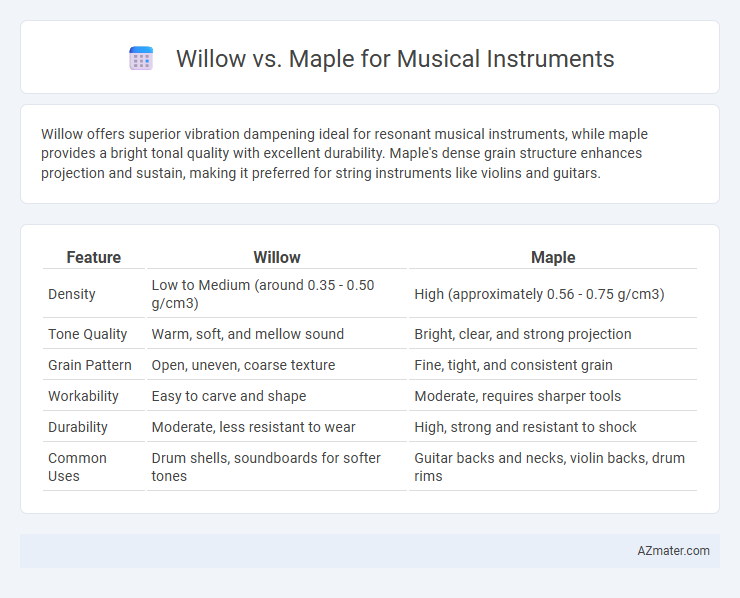Willow offers superior vibration dampening ideal for resonant musical instruments, while maple provides a bright tonal quality with excellent durability. Maple's dense grain structure enhances projection and sustain, making it preferred for string instruments like violins and guitars.
Table of Comparison
| Feature | Willow | Maple |
|---|---|---|
| Density | Low to Medium (around 0.35 - 0.50 g/cm3) | High (approximately 0.56 - 0.75 g/cm3) |
| Tone Quality | Warm, soft, and mellow sound | Bright, clear, and strong projection |
| Grain Pattern | Open, uneven, coarse texture | Fine, tight, and consistent grain |
| Workability | Easy to carve and shape | Moderate, requires sharper tools |
| Durability | Moderate, less resistant to wear | High, strong and resistant to shock |
| Common Uses | Drum shells, soundboards for softer tones | Guitar backs and necks, violin backs, drum rims |
Introduction: Willow vs Maple in Musical Instrument Crafting
Willow and maple are two popular woods used in crafting musical instruments due to their distinct tonal qualities and workability. Maple, known for its hardness and bright, clear sound, is commonly chosen for violins, cellos, and drum shells, providing durability and resonance. Willow, softer and lighter, is favored for its warm, mellow tone and is often used in percussion instruments like drumsticks and drum shells, offering excellent shock absorption and dynamic response.
Wood Characteristics: Willow and Maple Compared
Willow wood is lightweight and flexible, offering excellent resonance and a warm, mellow tone ideal for acoustic instruments. Maple is denser and harder, providing bright, clear sound with superior durability, making it popular for string instruments like violins and guitars. The contrasting grain structures affect both aesthetic appeal and tonal qualities, with willow's open grain enhancing warmth and maple's tight grain contributing to clarity and projection.
Acoustic Qualities: Sound Performance of Willow and Maple
Willow wood produces a warm, soft tone with excellent resonance, making it ideal for instruments that require rich mid-range frequencies and a mellow sound profile. Maple offers a bright, clear, and articulate acoustic performance with strong projection and crisp high-frequency response, favored in instruments needing sharp attack and sustain. The choice between willow and maple significantly influences the tonal character, projection, and overall sound quality of acoustic musical instruments.
Workability: Crafting Ease and Durability
Willow offers moderate workability with a softer grain that allows for easier carving and shaping, making it suitable for detailed instruments but less durable over time. Maple provides excellent workability due to its fine, consistent grain and hardness, ensuring smoother finishes and greater resistance to wear and impact. The durability of maple significantly outperforms willow, making it the preferred choice for long-lasting musical instruments exposed to frequent handling.
Cost and Availability of Willow and Maple
Willow wood tends to be less expensive than maple due to its faster growth rate and greater regional availability, making it a cost-effective option for musical instrument manufacturing. Maple, prized for its hardness and tonal brightness, is often more costly and less readily available, especially high-quality grades used in premium instruments. Availability of willow is generally higher in wetland regions and is more sustainable due to shorter harvest cycles, whereas maple requires longer growth periods, impacting both cost and supply stability.
Aesthetic Appeal: Grain, Color, and Finish Options
Willow and maple each offer distinct aesthetic qualities desirable in musical instrument crafting, with maple prized for its tight, uniform grain and bright, natural color variations ranging from creamy white to rich amber. Willow typically features a more pronounced, varied grain pattern with a softer, pale tone that highlights organic textures well under various finishes. Maple's versatility allows for high-gloss, matte, and stained finishes that enhance its reflective surface, while willow's finish options emphasize its raw, natural beauty, often favored for a rustic or vintage look.
Popular Instruments Made with Willow and Maple
Willow wood is frequently used in drum shells, especially snare drums, due to its lightweight and resonant qualities that produce a warm, focused sound favored by percussionists. Maple is a preferred choice for high-end violins, cellos, and guitars, prized for its strength, fine grain, and ability to enhance tonal brightness and sustain. Popular instruments crafted from maple include Fender Stratocaster electric guitars and many drum kits from brands like Ludwig and Yamaha, while willow is predominantly found in signature snare drums and specialized percussion pieces.
Player Preferences: Tone and Playability Considerations
Willow wood offers a warm, resonant tone favored by musicians seeking rich midrange frequencies, while maple provides a brighter, sharper sound ideal for cutting through ensemble mixes. Players often prefer willow instruments for genres requiring expressive dynamics and softer attack, whereas maple is chosen for its durability and articulate response, enhancing fast passages and precise playability. The choice between willow and maple heavily depends on the player's tonal goals and stylistic demands in performance.
Longevity and Maintenance of Willow vs Maple Instruments
Maple instruments exhibit exceptional longevity due to the wood's dense grain structure, which resists wear and environmental changes, ensuring stable performance over time. Willow, while offering a lighter tone and aesthetic appeal, generally requires more frequent maintenance because its softer, porous nature makes it more susceptible to dents and moisture damage. Choosing maple instruments benefits musicians seeking durability and minimal upkeep for long-term use.
Conclusion: Choosing the Right Wood for Your Musical Instrument
Willow offers exceptional resonance and warmth, making it ideal for instruments that benefit from softer tonal qualities, while maple provides bright, clear sound and durability suited for string and wind instruments demanding projection and stability. Consider the instrument's purpose and desired sound characteristics; willow enhances mellowness, and maple supports articulation and sustain. Selecting the right wood depends on balancing acoustic properties with the instrument's structural needs and the musician's tonal preference.

Infographic: Willow vs Maple for Musical Instrument
 azmater.com
azmater.com